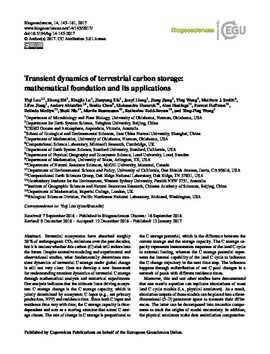| dc.creator | Luo, Yiqi | |
| dc.creator | Shi, Zheng | |
| dc.creator | Lu, Xingjie | |
| dc.creator | Xia, Jianyang | |
| dc.creator | Liang, Junyi | |
| dc.creator | Jiang, Jiang | |
| dc.creator | Wang, Ying | |
| dc.creator | Smith, Matthew J. | |
| dc.creator | Jiang, Lifen | |
| dc.creator | Ahlström, Anders | |
| dc.creator | Chen, Benito | |
| dc.creator | Hararuk, Oleksandra | |
| dc.creator | Hastings, Alan | |
| dc.creator | Hoffman, Forrest | |
| dc.creator | Medlyn, Belinda | |
| dc.creator | Niu, Shuli | |
| dc.creator | Rasmussen, Martin | |
| dc.creator | Todd-Brown, Katherine | |
| dc.creator | Wang, Ying-Ping | |
| dc.date.accessioned | 2017-02-07T16:46:08Z | |
| dc.date.available | 2017-02-07T16:46:08Z | |
| dc.date.issued | 2017-01-12 | |
| dc.identifier.citation | Luo, Y., Shi, Z., Lu, X., Xia, J., Liang, J., Jiang, J., Wang, Y., Smith, M. J., Jiang, L., Ahlström, A., Chen, B., Hararuk, O., Hastings, A., Hoffman, F., Medlyn, B., Niu, S., Rasmussen, M., Todd-Brown, K., and Wang, Y.-P.: Transient dynamics of terrestrial carbon storage: mathematical foundation and its applications, Biogeosciences, 14, 145-161, doi:10.5194/bg-14-145-2017, 2017. | en_US |
| dc.identifier.uri | https://hdl.handle.net/11244/48167 | |
| dc.description.abstract | Terrestrial ecosystems have absorbed roughly 30 % of anthropogenic CO2 emissions over the past decades, but it is unclear whether this carbon (C) sink will endure into the future. Despite extensive modeling and experimental and observational studies, what fundamentally determines transient dynamics of terrestrial C storage under global change is still not very clear. Here we develop a new framework for understanding transient dynamics of terrestrial C storage through mathematical analysis and numerical experiments. Our analysis indicates that the ultimate force driving ecosystem C storage change is the C storage capacity, which is jointly determined by ecosystem C input (e.g., net primary production, NPP) and residence time. Since both C input and residence time vary with time, the C storage capacity is time-dependent and acts as a moving attractor that actual C storage chases. The rate of change in C storage is proportional to the C storage potential, which is the difference between the current storage and the storage capacity. The C storage capacity represents instantaneous responses of the land C cycle to external forcing, whereas the C storage potential represents the internal capability of the land C cycle to influence the C change trajectory in the next time step. The influence happens through redistribution of net C pool changes in a network of pools with different residence times.
Moreover, this and our other studies have demonstrated that one matrix equation can replicate simulations of most land C cycle models (i.e., physical emulators). As a result, simulation outputs of those models can be placed into a three-dimensional (3-D) parameter space to measure their differences. The latter can be decomposed into traceable components to track the origins of model uncertainty. In addition, the physical emulators make data assimilation computationally feasible so that both C flux- and pool-related datasets can be used to better constrain model predictions of land C sequestration. Overall, this new mathematical framework offers new approaches to understanding, evaluating, diagnosing, and improving land C cycle models. | en_US |
| dc.description.sponsorship | This work was partially done through the working group, Nonautonomous Systems and Terrestrial Carbon Cycle, at the National Institute for Mathematical and Biological Synthesis, an institute sponsored by the National Science Foundation, the US Departmernt of Homeland Security, and the US Department of Agriculture through NSF award no. EF-0832858, with additional support from the University of Tennessee, Knoxville, Research in Yiqi Luo EcoLab was financially supported by US Department of Energy grants DE-SC0008270, DE-SC0014085, and US National Science Foundation (NSF) grants EF 1137293 and OIA-1301789. | en_US |
| dc.format.extent | 17 pages | |
| dc.format.extent | 2,256,222 bytes | |
| dc.format.medium | application.pdf | |
| dc.language | en_US | en_US |
| dc.relation.requires | Adobe Acrobat Reader | |
| dc.rights | Attribution 3.0 United States | * |
| dc.rights.uri | https://creativecommons.org/licenses/by/3.0/us/ | * |
| dc.subject.lcsh | Carbon sequestration -- Mathematical models | en_US |
| dc.title | Transient dynamics of terrestrial carbon storage : mathematical foundation and its applications | en_US |
| dc.type | Article | en_US |
| dc.type | text | |
| dc.description.peerreview | Yes | en_US |
| dc.identifier.doi | 10.5194/bg-14-145-2017 | en_US |
| ou.group | College of Arts and Sciences::Department of Microbiology and Plant Biology | en_US |

